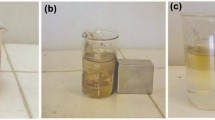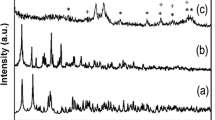Abstract
Tunable manufacturing using flexible building blocks to bring functionalities while providing long-term stabilization for small-sized nanomaterials occupies a forefront position in nanoscience and nanotechnology. Iron oxide nanoparticles are among the most promising nano-objects, owing to their inherent magnetic properties. The propensity of iron oxide to aggregate constitutes a serious drawback for many of their potential properties that need to keep their size at the nanoscale. Hosting iron oxide in porous supports, intercalation in layered nanostructures or shelling with tunable partners are common approaches used for their stabilization. We herein report the controlled growth of iron oxide using cleverly crafted sol-gel transformable siloxane precursors. These flexible building blocks provide an entry to iron oxide encapsulated in hydrophobic silica, denoted as Fe3O4@PMSiO2, while the use of commercially available TEOS afforded Fe3O4@SiO2. Owing to the presence of PDMS-like segments, the grown Fe3O4 exhibits distinctive features in terms of the crystal size, restricted growth and dispersion in organic solvents compared to native iron oxide and those grown in conventional silica supports. Upon calcination at 500 °C, the size of the crystal expands by 25.4 nm in the case of native Fe3O4 reaching 35.9 nm. Comparatively, marginal expansion was observed using our siloxanes, with the size of those grown in Fe3O4@OMSiO2 and Fe3O4@PMSiO2 being restricted to 14.3 nm and 11.7 nm, because of the stabilization brought by the siloxane layers. Furthermore, Fe3O4@OMSiO2 and Fe3O4@PMSiO2 are fully soluble in apolar heptane and hexane, which convincingly substantiate the hydrophobic nature of the resulting mixed oxide materials.
Graphical Abstract

The growth of iron oxide nanoparticles was investigated in the presence of amphiphilic siloxane containing polymerizable alkoxysilyl fragments and hydrophobic PDMS-like segments.
Highlights
-
The growth of iron oxide nanoparticles in the presence of sol-gel processable PDMS-like silica precursor.
-
The bulkiness of the used PDMS-like precursor restricts the expansion of iron oxide nanoparticles.
-
The presence of a hydrophobic segment allows for dispersing iron oxide in non-polar solvents.










Similar content being viewed by others
References
Ling D, Lee N, Hyeon T (2015) Chemical synthesis and assembly of uniformly sized iron oxide nanoparticles for medical applications. Acc Chem Res 48:1276–1285. https://doi.org/10.1021/acs.accounts.5b00038
Mahmoudi M, Hofmann H, Rothen-Rutishauser B, Petri-Fink A (2012) Assessing the in vitro and in vivo toxicity of superparamagnetic iron oxide nanoparticles. Chem Rev 112:2323–2338. https://doi.org/10.1021/cr2002596
Zhang Q, Yang X, Guan J (2019) Applications of magnetic nanomaterials in heterogeneous catalysis. ACS Appl Nano Mater 2:4681–4697. https://doi.org/10.1021/acsanm.9b00976
Kumar P, Tomar V, Kumar D, Joshi RK, Nemiwal M (2022) Magnetically active iron oxide nanoparticles for catalysis of organic transformations: a review. Tetrahedron 106-107:132641. https://www.sciencedirect.com/science/article/pii/S0040402022000175
Fernández L, González-Rodríguez J, Gamallo M, Vargas-Osorio Z, Vázquez-Vázquez C, Piñeiro Y, Rivas J, Feijoo G, Moreira MT (2020) Iron oxide-mediated photo-Fenton catalysis in the inactivation of enteric bacteria present in wastewater effluents at neutral pH. Environ Pollut 266:115181. https://www.sciencedirect.com/science/article/pii/S0269749120332036
Urbanova V, Magro M, Gedanken A, Baratella D, Vianello F, Zboril R (2014) Nanocrystalline iron oxides, composites, and related materials as a platform for electrochemical, magnetic, and chemical biosensors. Chem Mater 26:6653–6673. https://doi.org/10.1021/cm500364x
Ashraf M, Khan I, Usman M, Khan A, Shah SS, Khan AZ, Saeed K, Yaseen M, Ehsan MF, Tahir MN, Ullah N (2020) Hematite and magnetite nanostructures for green and sustainable energy harnessing and environmental pollution control: a review. Chem Res Toxicol 33:1292–1311. https://doi.org/10.1021/acs.chemrestox.9b00308
Mahmoudi M, Sahraian MA, Shokrgozar MA, Laurent S (2011) Superparamagnetic iron oxide nanoparticles: promises for diagnosis and treatment of multiple sclerosis. ACS Chem Neurosci 2:118–140. https://doi.org/10.1021/cn100100e
Nabavinia M, Beltran-Huarac J (2020) Recent progress in iron oxide nanoparticles as therapeutic magnetic agents for cancer treatment and tissue engineering. ACS Appl Bio Mater 3:8172–8187. https://doi.org/10.1021/acsabm.0c00947
Shen Z, Wu A, Chen X (2017) Iron oxide nanoparticle based contrast agents for magnetic resonance imaging. Mol Pharmaceutics 14:1352–1364. https://doi.org/10.1021/acs.molpharmaceut.6b00839
Lee N, Yoo D, Ling D, Cho MH, Hyeon T, Cheon J (2015) Iron oxide based nanoparticles for multimodal imaging and magnetoresponsive therapy. Chem Rev 115:10637–10689. https://doi.org/10.1021/acs.chemrev.5b00112
Pucci C, Degl’Innocenti A, Belenli Gümüş M, Ciofani G (2022) Superparamagnetic iron oxide nanoparticles for magnetic hyperthermia: recent advancements, molecular effects, and future directions in the omics era. Biomater Sci 10:2103–2121. https://doi.org/10.1039/D1BM01963E
Wahsner J, Gale EM, Rodríguez-Rodríguez A, Caravan P (2019) Chemistry of MRI contrast agents: current challenges and new frontiers. Chem Rev 119:957–1057. https://doi.org/10.1021/acs.chemrev.8b00363
Gao Y, Shi X, Shen M (2021) Intelligent design of ultrasmall iron oxide nanoparticle-based theranostics. ACS Appl Mater Interfaces 13:45119–45129. https://doi.org/10.1021/acsami.1c13341
Guzy J, Chakravarty S, Buchanan FJ, Chen H, Gaudet JM, Hix JML, Mallett CL, Shapiro EM (2020) Complex relationship between iron oxide nanoparticle degradation and the signal intensity in magnetic particle imaging. ACS Appl Nano Mater 3:3991–3999. https://doi.org/10.1021/acsanm.0c00779
Shi Z, Neoh KG, Kang ET, Shuter B, Wang S-C, Poh C, Wang W (2009) Carboxymethyl)chitosan-Modified Superparamagnetic Iron Oxide Nanoparticles for Magnetic Resonance Imaging of Stem Cells. ACS Appl Mater. Interfaces. 1:328–335. https://doi.org/10.1021/am8000538
Huang J, Bu L, Xie J, Chen K, Cheng Z, Li X, Chen X (2010) Effects of nanoparticle size on cellular uptake and liver MRI with polyvinylpyrrolidone-coated iron oxide nanoparticles. ACS Nano 4:7151–7160. https://doi.org/10.1021/nn101643u
Strable E, Bulte JWM, Moskowitz B, Vivekanandan K, Allen M, Douglas T (2001) Synthesis and characterization of soluble iron oxide−dendrimer composites. Chem Mater 13:2201–2209. https://doi.org/10.1021/cm010125i
Frankamp BL, Boal AK, Tuominen MT, Rotello VM (2005) Direct control of the magnetic interaction between iron oxide nanoparticles through dendrimer-mediated self-assembly. J Am Chem Soc 127:9731–9735. https://doi.org/10.1021/ja051351m
Alvarez NT, Orbaek A, Barron AR, Tour JM, Hauge RH (2010) Dendrimer-assisted self-assembled monolayer of iron nanoparticles for vertical array carbon nanotube growth. ACS Appl Mater Interfaces 2:15–18. https://doi.org/10.1021/am900666w
Carrillo AI, Serrano E, Luque R, García-Martínez J (2013) Microwave-assisted catalysis by iron oxide nanoparticles on MCM-41: effect of the support morphology. Appl Catal A Gen 453:383–390. https://www.sciencedirect.com/science/article/pii/S0926860X12008186
Moodley P, Scheijen FJE, Niemantsverdriet JW, Thüne PC (2010) Iron oxide nanoparticles on flat oxidic surfaces—Introducing a new model catalyst for Fischer–Tropsch catalysis. Catal Today 154:142–148. https://www.sciencedirect.com/science/article/pii/S0920586110001872
Sanchis R, Cecilia JA, Soriano MD, Vázquez MI, Dejoz A, López Nieto JM, Rodríguez Castellón E, Solsona B (2018) Porous clays heterostructures as supports of iron oxide for environmental catalysis. Chem Eng J 334:1159–1168. https://www.sciencedirect.com/science/article/pii/S138589471731968X
Yang J, Luo Y, Xu Y, Li J, Zhang Z, Wang H, Shen M, Shi X, Zhang G (2015) Conjugation of iron oxide nanoparticles with RGD-modified dendrimers for targeted tumor MR imaging. ACS Appl Mater Interfaces 7:5420–5428. https://doi.org/10.1021/am508983n
Ding HL, Zhang YX, Wang S, Xu JM, Xu SC, Li GH (2012) Fe3O4@SiO2 Core/Shell Nanoparticles: The Silica Coating Regulations with a Single Core for Different Core Sizes and Shell Thicknesses. Chem Mater 24:4572–4580. https://doi.org/10.1021/cm302828d
Morel A-L, Nikitenko SI, Gionnet K, Wattiaux A, Lai-Kee-Him J, Labrugere C, Chevalier B, Deleris G, Petibois C, Brisson A, Simonoff M (2008) Sonochemical approach to the synthesis of Fe3O4@SiO2 core−shell nanoparticles with tunable properties. ACS Nano 2:847–856. https://doi.org/10.1021/nn800091q
Tuček J, Kemp KC, Kim KS, Zbořil R (2014) Iron-Oxide-Supported Nanocarbon in Lithium-Ion Batteries, Medical, Catalytic, and Environmental Applications. ACS Nano 8:7571–7612. https://doi.org/10.1021/nn501836x
Boni A, Albertazzi L, Innocenti C, Gemmi M, Bifone A (2013) Water Dispersal and Functionalization of Hydrophobic Iron Oxide Nanoparticles with Lipid-Modified Poly(amidoamine) Dendrimers. Langmuir 29:10973–10979. https://doi.org/10.1021/la400791a
Cai H, An X, Cui J, Li J, Wen S, Li K, Shen M, Zheng L, Zhang G, Shi X (2013) Facile Hydrothermal Synthesis and Surface Functionalization of Polyethyleneimine-Coated Iron Oxide Nanoparticles for Biomedical Applications. ACS Appl Mater Interfaces 5:1722–1731. https://doi.org/10.1021/am302883m
Laurent S, Forge D, Port M, Roch A, Robic C, Vander Elst L, Muller RN (2008) Magnetic Iron Oxide Nanoparticles: Synthesis, Stabilization, Vectorization, Physicochemical Characterizations, and Biological Applications. Chem Rev 108:2064–2110. https://doi.org/10.1021/cr068445e
Kievit FM, Zhang M (2011) Surface Engineering of Iron Oxide Nanoparticles for Targeted Cancer Therapy. Acc Chem Res 44:853–862. https://doi.org/10.1021/ar2000277
Leung KC-F, Xuan S, Lo C-M (2009) Reversible Switching between Hydrophilic and Hydrophobic Superparamagnetic Iron Oxide Microspheres via One-Step Supramolecular Dynamic Dendronization: Exploration of Dynamic Wettability. ACS Appl Mater Interfaces 1:2005–2012. https://doi.org/10.1021/am900367a
Hsu R-S, Chang W-H, Lin J-J (2010) Nanohybrids of Magnetic Iron-Oxide Particles in Hydrophobic Organoclays for Oil Recovery. ACS Appl Mater Interfaces 2:1349–1354. https://doi.org/10.1021/am100019t
Amrillah T, Abdullah CAC, Sari DP, Mumtazah Z, Adila FP, Astuti F (2021) Crafting a Next-Generation Device Using Iron Oxide Thin Film: A Review. Cryst Growth Des 21:7326–7352. https://doi.org/10.1021/acs.cgd.1c00841
Etemadi H, Buchanan JK, Kandile NG, Plieger PG (2021) Iron Oxide Nanoparticles: Physicochemical Characteristics and Historical Developments to Commercialization for Potential Technological Applications. ACS Biomater Sci Eng 7:5432–5450. https://doi.org/10.1021/acsbiomaterials.1c00938
El Kadib A, Finiels A, Marcotte N, Brunel D (2013) Self-templating amphiphilic polysiloxanes to design nanostructured silica-based architectures. Chem Commun 49:5168–5170. https://doi.org/10.1039/C3CC41943F
Finiels A, Alonso B, Bousmina M, Brunel D, El Kadib A (2016) Periodic mesoporous organosilicas derived from amphiphilic bulky polymethylsiloxane. N. J Chem 40:4132–4135. https://doi.org/10.1039/C5NJ01824B
Kacem M, Katir N, El Haskouri J, Essoumhi A, El Kadib A (2021) Gold nanoparticles grown on a hydrophobic and texturally tunable PDMS-like framework. N. J Chem 45:10232–10239. https://doi.org/10.1039/D1NJ00274K
Brand RA, Lauer J, Herlach DM (1983) The evaluation of hyperfine field distributions in overlapping and asymmetric Mossbauer spectra: a study of the amorphous alloy Pd77.5-xCu6Si16.5Fex. J Phys F Met Phys 13:675–683. https://doi.org/10.1088/0305-4608/13/3/018
Brahmi Y, Katir N, Ianchuk M, Collière V, Essassi EM, Ouali A, Caminade A-M, Bousmina M, Majoral JP, El Kadib A (2013) Low temperature synthesis of ordered mesoporous stable anatase nanocrystals: the phosphorus dendrimer approach. Nanoscale 5:2850–2856. https://doi.org/10.1039/C3NR00058C
Brahmi Y, Katir N, Agullo JAM, Primo A, Bousmina M, Pierre Majoral J, Garcia H, El Kadib A (2015) Organophosphonate bridged anatase mesocrystals: low temperature crystallization, thermal growth and hydrogen photo-evolution. Dalton Trans 44:15544–15556. https://doi.org/10.1039/C5DT02367J
Kim DK, Mikhaylova M, Zhang Y, Muhammed M (2003) Protective Coating of Superparamagnetic Iron Oxide Nanoparticles. Chem Mater 15:1617–1627. https://doi.org/10.1021/cm021349j
Kamali-M S, Ericsson T, Wäppling R (2006) Characterization of iron oxide nanoparticles by Mössbauer spectroscopy. Thin Solid Films 515:721–723. https://www.sciencedirect.com/science/article/pii/S0040609005025071
Glaria A, Soulé S, Hallali N, Ojo WS, Mirjolet M, Fuks G, Cornejo A, Allouche J, Dupin JC, Martinez H, Carrey J, Chaudret B, Delpech F, Lachaize S, Nayral C (2018) Silica coated iron nanoparticles: synthesis, interface control, magnetic and hyperthermia properties. RSC Adv 8:32146–32156. https://doi.org/10.1039/C8RA06075D
Acknowledgements
UEMF is acknowledged for financial support.
Author information
Authors and Affiliations
Corresponding author
Ethics declarations
Conflict of interest
The authors declare no competing interests.
Additional information
Publisher’s note Springer Nature remains neutral with regard to jurisdictional claims in published maps and institutional affiliations.
Supplementary information
Rights and permissions
Springer Nature or its licensor (e.g. a society or other partner) holds exclusive rights to this article under a publishing agreement with the author(s) or other rightsholder(s); author self-archiving of the accepted manuscript version of this article is solely governed by the terms of such publishing agreement and applicable law.
About this article
Cite this article
Kacem, M., Katir, N., Essoumhi, A. et al. Investigating the growth, thermal expansion and dispersion of iron oxide in presence of nanostructured siloxane containing hydrophobic PDMS-like segments. J Sol-Gel Sci Technol 107, 783–793 (2023). https://doi.org/10.1007/s10971-023-06152-4
Received:
Accepted:
Published:
Issue Date:
DOI: https://doi.org/10.1007/s10971-023-06152-4




